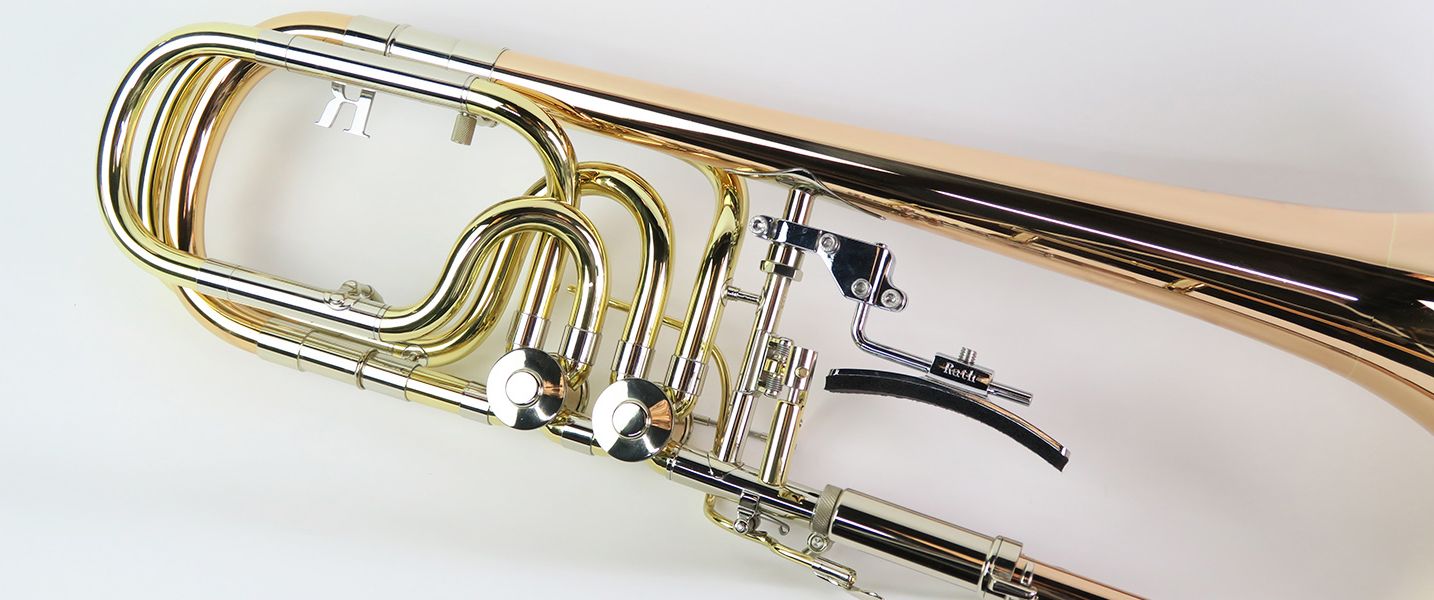
Hand Support

Players are becoming ever more aware of the problems caused by excessive tension and physical strain when holding and playing the trombone especially in situations such as marching or simply performing for extended periods without a break. It can affect a wide range of players, from young children to those with conditions such as arthritis. The Michael Rath hand support system is a very simple yet very effective way of reducing, and in many cases eliminating, physical tension in the hand, arm and shoulder.
Musically, the benefits of being able to perform free from unnecessary tension can be considerable and often this can also lead to a reduction of excessive pressure on the embouchure.
Attaching to the main bell stay of the instrument, the pad of the Michael Rath hand support fits snugly across the back of the left hand, providing all the necessary support needed to eliminate tension from the fingers. When properly adjusted a player can even remove their fingers from the slide stay completely leaving the hand support to take the full weight of the instrument.
The Michael Rath hand support has been designed and successfully tested with a number of different makes and models of trombone, in addition to all Rath instruments, and, as well as its popular use with bass and contra bass trombones, the hand support has proven to be equally as successful with Bb/F tenor and even straight tenor trombones.
The Michael Rath hand support comes as a very simple kit which is easy to fit and adjust though care should be taken to not over tighten the screws as this may damage the bell stay. For Michael Rath hand support assembly see our fitting instructions.
How to order
If you’re in the UK, please contact us to order a hand support, or alteratively if you’re outside the UK, please contact your nearest Rath dealer .

REVIEW: RATH HANDBRACE
I started playing the trombone at the tender age of eight. My first instrument was a small-bore children’s trombone but at the age of around thirteen, I was fortunate enough to move onto a large bore professional standard trombone with a trigger. I loved this instrument and played it regularly through my teens and early twenties. I played in a wide variety of ensembles but the ones I enjoyed the most were my local authority youth brass band and a local amateur brass ensemble which was called The English Brass Group. When I started university, I wanted to continue playing with other brass players and so I founded The University of Warwick Brass Society. However, later in my twenties, I started to find it very difficult to hold the trombone in my left hand. I suspected that the trigger was causing the problem and perhaps being slim build, the weight was too much for me. So, I decided to exchange my trombone for another large bore professional standard instrument but this time without a trigger. This seemed to work for me for a while. But later into adult life, I started experiencing uncomfortable symptoms in my left hand again.
During brass band rehearsals, I would get pins and needles in my left hand and fingertips. This was followed by numbness and tingling at night. The more I played the trombone, the worse it got and I noticed that there were signs of muscle wastage on the palm of my left hand. I sought medical attention and was diagnosed with carpal tunnel syndrome by the hand unit at my local hospital. It seems that whilst holding a trombone, I had been crushing a nerve that was getting damaged. I was given the option of surgery which I am still considering, but in the meantime looked at other options for musical output. For the last two years, I have been playing an alternative brass instrument (with valves) that doesn’t cause any left-hand strain.
More recently, however, I have discovered Michael Rath’s hand support. At first, I was a bit skeptical because I had already tried a hand support made by another brand to no avail. But, I have now fitted the Rath hand support to my trombone and I am delighted to report that I can hold it comfortably again. I would say that my hands are smaller than the average trombonist’s and I have fitted it quite tightly against the back of my hand. It has enabled me to loosen my grip on the instrument significantly and for moments at a time, I can take the whole weight against the back of the hand rather than down the palm of the hand or wrist. I am now looking forward to having many opportunities to play again, perhaps for short periods to begin with.
I am curious about how many other trombonists have had similar issues. After all, the trombone is not an ergonomically designed instrument and most players would not have the opportunity to acquire a bespoke instrument. I highly recommend Michael Rath’s hand support for any trombonist needing to manage carpal tunnel syndrome or even trying to prevent it from developing. I know that the other trombonists in my current band are curious about trying it for themselves. Thank you Michael Rath for coming up with such an ingenious solution!
— Sarah Sterne
“Chairperson, The Putney and Wimbledon Brass Band”
How to fit your hand support
The Michael Rath hand support is very easy to fit to your trombone. This is a short step-by-step guide to fitting and adjusting your hand support correctly so that you get the best possible support.
This is the hand support kit. In it, you’ll find the two piece bracket which attaches to the main bell stay of your trombone, the hand support pad which will rest on the back of your left hand, four plastic rings, two “L” shaped arms and an allen key.


The first step is check to see if you need to fit one of the plastic rings to your bell stay before attaching the hand support. To do this, take the four allen screws out of the bracket and fit this around your bell stay.
Check to see if there is a gap between the circular hole in the hand support bracket and the bell stay. You can see that there is a gap on this trombone.
If there is a gap then select the appropriate ring to fill the gap and fit in around the main bell stay.
Rath alto, tenor, bass and contrabass trombones shouldn’t need a ring. but the JP/Rath student trombones will need a ring fitting to them.
With the ring in place check the bracket again as before – if there’s a gap, try fitting a different ring, if the bracket is a snug fit then you can fit the rest of the allen screws back into the bracket as shown. Don’t tighten the screws up all the way at this stage.
Once you have the bracket in place on your bell section connect one of the L shaped arms to the main hand support pad. The choice of which L shaped arm to use will depend on the position of the bracket that you’ve just fitted.
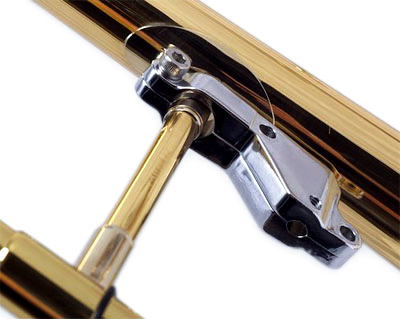
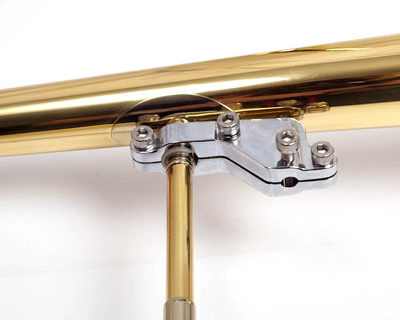
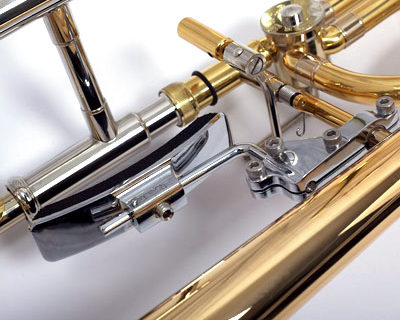
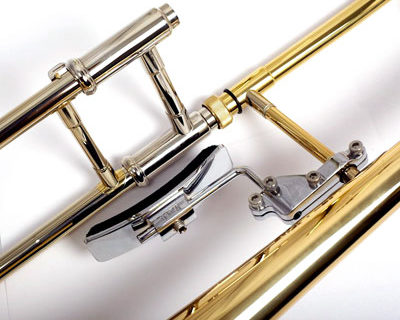
As a general guide, the squarer of the L arms is usually better for bass trombones, and the other L arm is generally better with tenor trombones, but you may need to try both to get the best position for the hand support on your trombone.
Now you can insert the other end of the L arm into the receiving hole on the bell stay bracket and tighten up the receiving screw.
Tighten the screws up to fasten the two pieces of the bracket back together taking care to tighten them evenly and not to overtighten. The hand support should be secure on the bell stay with very little or no movement in the bracket.
At this stage, you should have the hand support fully assembled, ready to adjust it to suit you.
The hand support is designed to give you as much flexibility as possible with the position of the pad on the back of your left hand. The pad can be rotated through 360° and moved up and down the L arm.
You need to adjust the position of the hand support pad so that it sits across the back of your left hand when you hold your trombone in the playing position. Your hand should fit snugly between the pad and your slide.
If the pad isn’t fitting snugly across the back of your left hand, it won’t give you the best support when you come to play your trombone. You might find that you need to loosen the screw on the bell stay bracket which connects to the L arm so that you can move the pad closer to your hand.
When the hand support is in the correct position you should be able to let go of the slide stay with the fingers of your left hand, leaving the hand support to take your trombone.
It’s worth spending some time doing this and experimenting with various positions for your hand support as experience with lots of players and different instruments has shown there is an optimal position that will dramatically increase your comfort when holding and playing your trombone.
Michael Rath hand supports have been designed and successfully tested with a number of different makes and models of the trombone in addition to all Rath instruments. Aside from perhaps more obvious applications with bass and contrabass trombones, has proven to be equally as successful with Bb/F tenor and Bb tenor trombones particularly for younger players.




